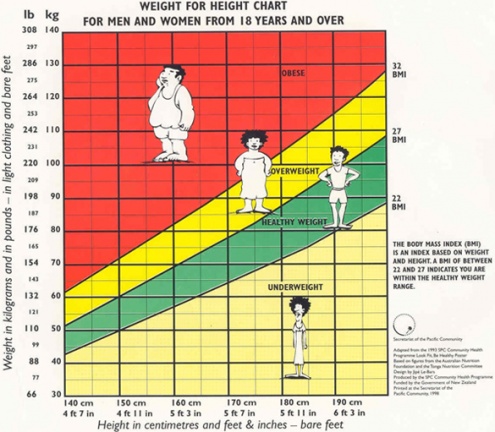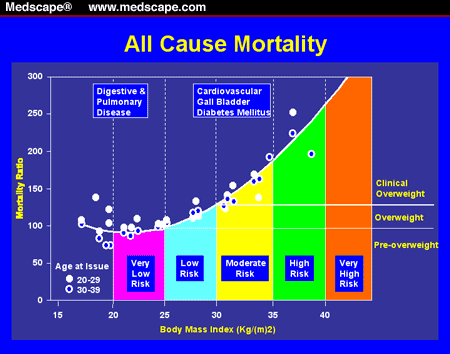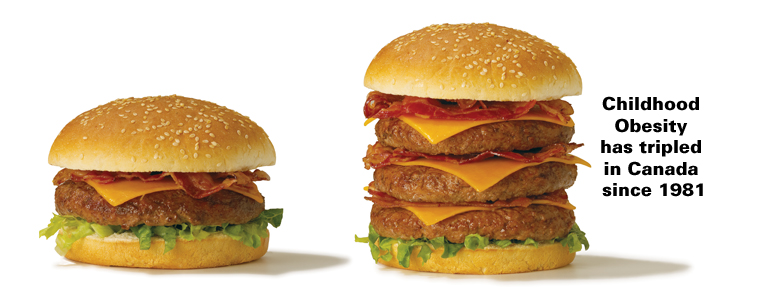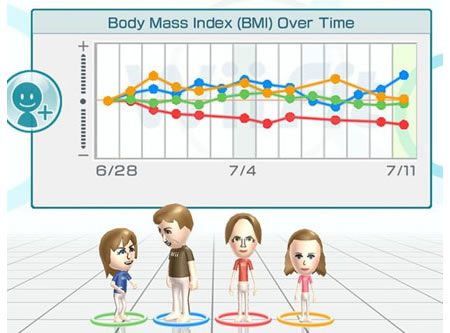DeAnza College/CIS2/Summer 2010/Group 3
| CIS 2 Computers and the Internet in Society SUMMER 2010 Final Project
ContentsObjective 1
Objective 2
|
What is Childhood Obesity
According to the Mayo Clinic, Childhood obesity[1] occurs when a child is well above the normal weight for his or her age and height.
Most cases of childhood obesity is caused by kids eating too much and exercising too little.
A pediatrician can determine whether or not a child's weight could pose health problems. The doctor can do this by calculating the child's body mass index(BMI.) The doctor will then compare the child's BMI to the other children of the same sex and age. Using a growth chart, the doctor should determine the percentile of the child's BMI. The cutoff points of these growth charts are supplied by the CDC as follows:-BMI-for-age between 85th and 94th percentile = overweight
-BMI-for-age 95th percentile or above = obesity
Individuals that are interested in checking their BMI can use a BMI Calculator.
Risk factors from childhood obesity include:
- diet
- lack of exercise
- family history
- psychological factors
- family factors
- socioeconomic factors
Complications from childhood obesity include:
- type 2 diabetes
- metabolic syndrome
- high cholesterol
- high blood pressure
- asthma
- sleep disorders
- early puberty or menstruation
- low self esteem and bullying
- behavior problems
- learning problems
- depression
Why is Child Obesity Important?
There are many factors that contribute to the importance of Child Obesity. The main factors include health and emotional/psychological problems, rising mortality rate and an increase in healthcare costs. Child Obesity can have immediate effects during the life as a child and effects that gradually increase through adult life.[2]
Health and Emotional/Psychological Problems
Child Obesity can lead to depression, lack of self-esteem and a risk of eating disorders. Child Obesity contributes to different health problems that include: Insulin Resistance, Type 2 Diabetes, Hypertension, High Total and LDL Cholesterol and triglyceride levels in the blood, Low HDL Cholesterol levels in the blood, Sleep Apnea, Early puberty, Orthopedic problems such as Blount's disease and slipped capital femoral epiphysis, and non-alcoholic steatohepatitis (fatty infiltration and inflammation of the liver)[3]
Mortality Rate
Most studies show an increase in mortality rates associated with obesity. Individuals who are obese have a significantly increased risk of death from all causes, compared with healthy weight individuals (BMI 18.5 to 24.9). The increased risk varies by cause of death, and most of this increased risk is due to cardiovascular causes. Obesity is associated with over 112,000 excess deaths due to cardiovascular disease, over 15,000 excess deaths due to cancer, and over 35,000 excess deaths due to non-cancer, non-cardiovascular disease causes per year in the U.S. population, relative to healthy-weight individuals. [4] Unhealthy weight gain due to poor diet and lack of exercise is responsible for over 300,000 deaths each year. [5]
Healthcare Costs
On average, people who are considered obese pay $1,429 (42 percent) more in health care costs than normal-weight individuals. For each obese patient[6]:
- Medicare pays $95 more for an inpatient service, $693 more for a non-inpatient service, and $608 more for prescription drugs in comparison with normal-weight patients [7]
- Medicaid pays $213 more for an inpatient service, $175 more for a non-inpatient service, and $230 more for prescription drugs in comparison with normal-weight patients.
- Private insurers pay $443 more for an inpatient service, $398 more for a non-inpatient service, and $284 more for prescription drugs in comparison with normal-weight patients.
History of Child Health
The Marriage and Family Encyclopedia said it best in the article, Children's Rights-Issues for the Future[8]:Globalization will bring about powerful new linkages among people and nations through law, technology, the media, and the marketplace. An important question is how these new linkages will affect the lives of families and children across the world. The last decade of the twentieth century witnessed an unprecedented increase in the level of international cooperation around the issue of children's rights. The status of children and their social, intellectual, and physical welfare came to be a topic of great worldwide concern, and calls were raised for the creation of clear universal guidelines to ensure that children's rights were protected around the globe.If a child's physical welfare is of concern, then childhood obesity would be a cause of global concern. The increase in childhood obesity is alarming. Danielle Seigle (2009) states in the article History of Childhood Obesity[9],
Over the past three decades, the childhood obesity rate has more than doubled for preschool children aged 2-5 years and adolescents aged 12-19 years, and it has more than tripled for children aged 6-11 years. At present, approximately nine million children over 6 years of age are considered obese.Throughout the decades, laws have been put into place to protect the well being of children. In the 19th century, the Industrial Revolution caused laws to be passed in order to protect children who were working in factories, mines and mills. As years go by, new problems arise which call for new laws to be put in place. A new problem which is on the rise is childhood obesity.
Technology
Computer technology is an important tool in modern society. People use such technology to make their lives better off. By using computers and the internet, people can entertain themselves, work at home or study overseas. However, computer technology brings not only happiness, it also cause troubles. There was a mother who was so addicted to the Facebook that has left her baby alone for days. The most common problem cause by over using computer is obesity. Children, adolecents and adults who use too much computer per day may be overweight easily. Technology has it own advantages and disadvantages and they are both critical to people and the society.
Advantages of Technology
The internet has offered large amounts of infomation about how to live healthy. Harvard University posted a healthy eating pyramid based on the latest science. The builder of the pyramid in the nutrition department of Harvard stated that:"Based on the latest science, and unaffected by businesses and organizations with a stake in its messages, the Healthy Eating Pyramid is a simple, trustworthy guide to choosing a healthy diet. Its foundation is daily exercise and weight control, since these two related elements strongly influence your chances of staying healthy. The Healthy Eating Pyramid builds from there, showing that you should eat more foods from the bottom part of the pyramid (vegetables, whole grains) and less from the top (red meat, refined grains, sugary drinks, and salt)"[10]Besides the fact of nutrition help, more advantages of computer technology are here to help people. In Japan, Nintendo company developed a game console called "Wii" to help people keep fit. With this gaming console, players have to do different actions in order to let the character in the game acts the way people want it to, like run, jump, or punch. The designer of Wii informed that:"Wii Fit is a video game offering fun and fitness to the user. The main advantage of wii fit is, it doesn’t provide just only video game but also helps user to be physical fit. The exercise games have four different categories--balance, yoga, strength and aerobic. These provide a core workout movement to the user. Truly a perfect fitness tool turning the living room into fitness centre for whole family." Wii does not only provide entertainment, it also make people, especially children, exercise by their own will.[11]Computers can help with educating people and developing different kinds of abilities with the help of the internet. Every single computer application has its way of helping people. "Daymare Town" is a online flash game that only people with good inference ability can easiy escape from the strange town. By playing this little game, people can improve their ability of logical thinking, and be able to connect revelant things together more easily and reasonably.[12]
Computers and the internet also inform people in many aspects. The government has built up a website of nutrition and healthy eating to give people advice on eating well and ways to stay fit. To do so, the website has provided many useful links and information, including: nutrition/diet suggestions, dietary guidelines for Americans and some links about food-safety issues.[13]Disadvantages of Technology
Technology is a double-edged sword. It benefits people from one hand yet harms people on the other hand. Computer games may help improve people's abilities, but what the games have done more is making children less mobile. Playing a computer game may cost a long period of time and children wouldn't want to go out unless he has finished the whole game or a specific chapter. Playing too much computer games will lower children's social skills such as how to negotiate with people peacefully and with proper manners. Not going outside also make those children less friends, which may have impact on children's personality. CNET news pointed out that playing too much games may hurt brain development "Scientists at Japan's Tohoku University said they've found that computer games stimulate only those parts of the brain devoted to vision and movement and do not aid the development of other important areas of the brain."[14] A professor from Tohoku University in Japan stated that:"There is a problem we will have with a new generation of children--who play computer games--that we have never seen before," he said. "The implications are very serious for an increasingly violent society, and these students will be doing more and more bad things if they are playing games and not doing other things like reading aloud or learning arithmetic."[14]Another bad result of playing to much on the computer is children will receive very limited and one-sided media infomation so that they are easy to be lured. During the Shanghai Expo, a Korean band "Super Junior" came to Shanghai to perform a live show. It said that the fans were to much in a frenzy and caused a stampede accident. Noticing this tragedy, many Chinese netizens felt so angry that they got together planned an online protest. On June, 9th, thousands of netizens started their so called "protest" towards the official website of "Super Junior" and the BBS of Super Junior fans. They used their hacking skills to "blow those websites off", and caused paralysis to both websites. However, after this illogical action, one of the planners said all of them were cheated and "Now that I have thought about what we have done, I think we are all fooled."[15]
Spending too much time on computers may also cause dietary problems. Children who are addicted to computer will tend to eat more fast food since they need more time on computer. Such requirement may cause obesity and harm their bodies. With more and more children buying fast food, fast food companies will lower the price and so more people will be attracted to eat them, which may cause more obesity problems in the country.
What Society Is Doing To Combat Childhood Obesity
Parents: Healthy eating habits and healthy choices start in the home. There are a variety of ways to teach kids the importance of eating healthy and exercising regularly. Due to technology, ideas are just a click away. With the advancement of technology parents can research their child's nutritional needs, look up healthy kid friendly recipes, participate in parenting blogs and research ideas on how to raise health conscience kids.
Schools: Unfortunately, due to budget cuts in education, physical education classes have been cut from everyday school curriculum. Although California State Standards still require a certain amount of physical education hours per week, many credentialed physical education teachers have been laid off, taking their wealth of knowledge with them. Thus, physical education, which involves much more than playing on the playground, is left up to the classroom teacher. Where does a classroom teacher get P.E ideas, exercises, assessments and lesson plans? The answer is simple. The internet. One great on-line resource is PE Central.org. PE Central is an organization that provides free, online information on how to implement a physical education program in your school or classroom. Items include:
- Lesson plans appropriate for all age groups
- Adaptive exercises for special needs students
- Ideas on PE rules and classroom management, including how long each class should be
- Website for kids encouraging exercise and proper nutrition
- List of grants in which schools can apply to buy PE equipment
PE Central and other online resources have helped educators and parent volunteers in understanding how to provide a proper physical education curriculum to students.
With school districts and teachers in a budget crunch, free, researched-based online resources can provide a well-rounded educational program. The National Dairy Council, provides free curriculum, on-line resources, music CD's and DVD's to teachers to help educate kids on proper nutrition. The computer lab can easily be turned into a nutrition and exercise learning environment with websites, such as Nutrition Exploration, and Nourish Interactive.
Cupertino Union School District's Student Nutrition Website states, "Proper nutrition in the school age years can reinforce lifelong eating habits that contribute to a student's overall well being. This will help them to grow and learn to their fullest potential... and then go on to lead a long healthy life"[16].
Many schools have adopted a Wellness Policy in order to address the importance of nutrition and exercise among students. Cupertino Union School District,(CUSD) in Cupertino, California has a website in which parents and educators can access school menus, the wellness policy and information on why a wellness policy is so important.Some of the key components of the CUSD Wellness Policy [17] include the following:
- Posting posters that promote wellness in food serving areas
- Encouraging to students to eat nutritious foods during school hours and after-school activities
- Foods sold on campus comply with the USDA guidelines
- Nutrition education will be part of the health program for all students
- Professional development provided to educators to insure proper teaching of nutrition
- Nutrition information on foods sold on campus will be posted at school and on district website
Although there are disadvantages associated in regards to childhood obesity and technology, there are advantages too. Due to the power of technology parents, educators and organizations can combat the process of childhood obesity and other health related illnesses. Teaching good eating habits and the importance of exercising can start at a very young age. As shown above, many parents, school officials and districts are taking a stand with the ever growing obesity problem.
Childhood Obesity and the Future
Currently, the new health care reform has added measures to ensure a decrease in the rate of childhood obesity.[18] Also, the first lady of the United States, Michelle Obama, along with her colleagues have introduced a plan to fight childhood obesity. She can be seen talking about this issue in this video. There are many things that society is doing to help decrease the amount of obese and overweight children. However, there will always be changing factors in our lives that can alter the preventative steps we put in place. In order to keep up with changing times, society will have to work in making sure the steps against childhood obesity are always kept up to date.
References
- ↑ http://www.mayoclinic.com/health/childhood-obesity/DS00698
- ↑ Childhood Overweight.(n.d.para.2.) Retrieved from http://www.obesity.org/information/childhood_overweight.asp
- ↑ Childhood Overweight.(n.d.para.2.) Retrieved from http://www.obesity.org/information/childhood_overweight.asp
- ↑ Statistics Related to Overweight and Obesity.(n.d.para.5.) Retrieved from http://www.win.niddk.nih.gov/statistics/index.htm
- ↑ Childhood Obesity Statistics and Trends.(n.d.para.1.)Retrieved from http://www.stop-childhood-obesity.com/childhood-obesity-statistics.html
- ↑ Statistics Related to Overweight and Obesity.(n.d.para.6.) Retrieved from http://www.win.niddk.nih.gov/statistics/index.htm
- ↑ Estimated County-Level Prevalence of Diabetes and Obesity --- United States, 2007 retrieved from: http://www.cdc.gov/mmwr/preview/mmwrhtml/mm5845a2.htm
- ↑ Children's Rights-Issues For The Future.(n.d.para.1.) Retrieved on July 23, 2010 from http://family.jrank.org/pages/250/Childrens-Rights-Issues-Future.html
- ↑ Seigle,D.(2009).History of Childhood Obesity. Retrieved on July 23, 2010 from http://ezinearticles.com/?History-of-Childhood-Obesity&id=3090095
- ↑ http://www.hsph.harvard.edu/nutritionsource/what-should-you-eat/pyramid/
- ↑ http://www.spudmobile.co.uk/Nintendo-Wii-Fit.aspx
- ↑ http://www.pastelportal.com/stories/dmt/
- ↑ http://www.nutrition.gov/nal_display/index.php?info_center=11&tax_level=1
- ↑ 14.0 14.1 http://news.cnet.com/2100-1040-271849.html
- ↑ http://news.mop.com/domestic/2068283.shtmlfckLRfckLR(It's a Chinese website since there is no such interview on the U.S. internet)
- ↑ Nutrition is for Everyone.(n.d.para.1.) Retrieved on July 30, 2010 from http://www.schoolnutritionandfitness.com/index.php?page=parentstudentteacher&sid=1805092039571289
- ↑ Cupertino Union School District Student Wellness Policy.(n.d.) Retrieved on July 26, 2010 from http://www.schoolnutritionandfitness.com/index.php?page=wellnesspolicy&sid=1805092039571289
- ↑ http://www.americanprogress.org/issues/2010/05/childhood_obesity_epidemic.html








